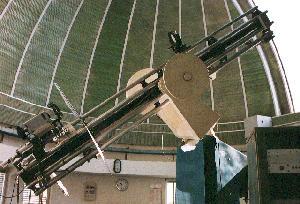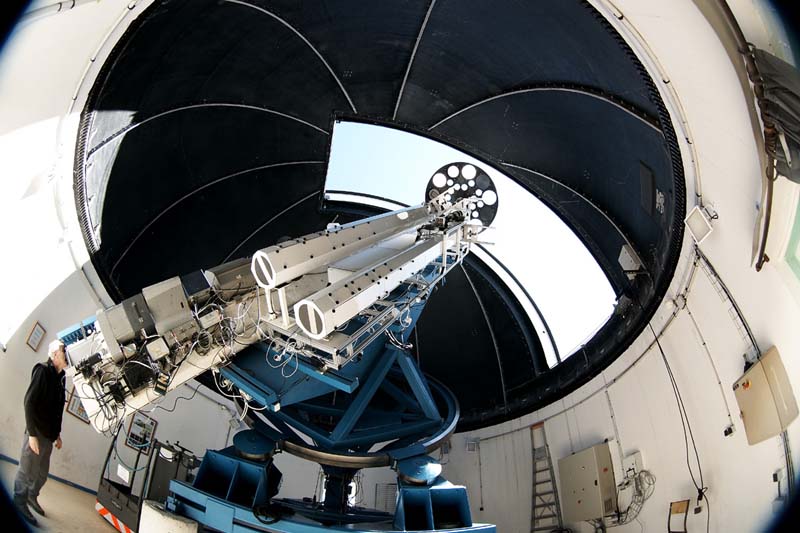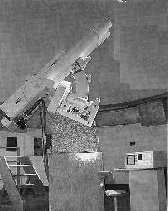
| BBSO's telescopes are specially designed for solar observations. A single fork mount supports the three main telescopes: a 65 cm reflector, a 25 cm refractor, and a 15 cm refractor. The 15 cm Singer telescope monitors the whole Sun in H-alpha. | ||
| Telescope Aperture: | 15 cm |  |
| Filter Bandpass: | 0.05 nm | |
| Tunable Filter Range: | +/- 0.10 nm | |
| Detector: | Apogee KX4 CCD Camera | |
| Detector Size: | 2032 x 2032 pixel | |
| Dynamic Range: | 14 bit | |
| At KSO the H-alpha observations are obtained with one of the three refractors of the monitoring instrument. | ||
| Telescope Aperture: | 10 cm |  |
| Filter Bandpass: | 0.07 nm | |
| Tunable Filter Range: | +/- 0.30 nm | |
| Detector: | Apogee KX4 CCD Camera | |
| Detector Size: | 2032 x 2032 pixel | |
| Dynamic Range: | 14 bit | |
| At OACt the H-alpha observations are performed with a 15 cm refractor (focal length 230 cm) mounted on an equatorial spar. | ||
| Telescope Aperture: | 15 cm |  |
| Filter Bandpass: | 0.025 nm / 0.05 nm | |
| Tunable Filter Range: | +/- 0.1 nm | |
| Detector: | Astromed TE4 CCD Camera | |
| Detector Size: | 1360 x 1200 pixel | |
| Dynamic Range: | 16 bit | |
| The Meudon spectroheliograph is dedicated to full
disk solar observations. It sonsists of *) a coelostat (two flat
mirrors of 45 cm); *) a horizontal refractor (25 cm aperture) and *) a
spectrograph. The full sun is scanned across the slit of the
spectrograph during about 1 mn. The profile of the H alpha spectral
line are recorded with a spectral resolution of 0.025 nm and the core
intensity is used to provide monochromatic images. We also provide
a "prominence" image. For that purpose we use a longer exposure time, so that
prominences appear more clearly on the solar limb. In order to avoid overexposure of
the solar disk, we put in front of it an artificial moon which consists of
a circular neutral density glass (ND 0.8). Other data products:
CaII K full disk images |
||
| Telescope Aperture: | 25 cm |  |
| Spectral Resolution: | 0.025 nm | |
| Tunable Filter Range: | N/A |
|
| Detector: | Princeton Instruments back illuminated
spectroscopic CCD |
|
| Detector Size: | 1340 x 100 pixel (image size 1500 x 1340 pixel) |
|
| Dynamic Range: | 14 bit | |
| At Pic du Midi Observatory, the H-alpha observations
of the full disk and the limb are obtained by the new solar instrument, CLIMSO.
CLIMSO is a set of two 20 cm. coronagraphs (focal length 245 cm) and two 9 cm.
refractors (focal length: 230 cm). CLIMSO is used in a daily survey mode since
2007, may. CLIMSO is operated by the "Observateurs Associés" team. |
||
| Telescope Aperture: | 9 cm |  |
| Spectral Resolution: | ||
| Tunable Filter Range: | +/-0.1 nm |
|
| Detector: | Apogee U4000 Kodak KAI-4021M CCD Camera |
|
| Detector Size: | 2048x2048 pixels |
|
| Dynamic Range: | 16 bit | |
| The synoptic observations at YNAO are carried out in a solar tower which hosts a twin telescope. Both telescopes have 18 cm aperture and one of them is the full disk H-alpha telescope. | ||
| Telescope Aperture: | 18 cm |  |
| Filter Bandpass: | 0.05 nm | |
| Tunable Filter Range: | +/- 0.06 nm | |
| Detector: | Kodak Megaplus CCD Camera | |
| Detector Size: | 2K x 2K pixel | |
| Dynamic Range: | 8 bit | |
| Synoptic observations at HSO include: vector magnetic field and line-of-sight velocity field measurements both in the photosphere and chromosphere; full disk H-alpha observations. The typical cadence for the full disk H-alpha observations is one image every 10 min. However, the cadence can be increased up tp oner image every 3 seconds. | ||
| Telescope Aperture: | 14 cm | |
| Filter Bandpass: | 0.05 nm | |
| Tunable Filter Range: | +/- 3.2 nm | |
| Detector: | Kodak Megaplus 4.2i CCD Camera | |
| Detector Size: | 2K x 2K pixel | |
| Dynamic Range: | 8 bit | |